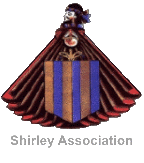

 |
|
||
| < Back to Hon. Laurence Shirley of Staunton Harold | |||
|
16(i). Laurence Shirley, 4th Earl Ferrers. He was hanged for murdering his chief Steward on 5 May 1760; Failing to produce a legitimate male heir, his title and estate passed to his next eldest brother Washington Shirley who became the 5th Earl Ferrers
The Hanging of Laurence Shirley, 4th Earl
Ferrers
As he grew older he developed a taste for drink. When he was sober he was a fine fellow, but when he was in his cups he became a brute with a tendency to violence. One day he was beaten in a horse race, so he thrashed his groom unconscious. On another occasion he stabbed a servant for refusing to perjure himself and say that a barrel of oysters had been bad when they had been delivered. He then beat him unconscious with a candlestick and kicked the man so hard in the groin that the servant was lamed for life. In 1752 he married the youngest daughter of Sir William Meredith. All was well to begin with but his darker side gradually emerged and one day he kicked her senseless. After six years she left him and returned to her family. She applied to Parliament for, and received, an order for maintenance. This came from a separate trust and was administered by Lord Ferrers' steward, John Johnson. The Earl and his household lived at Staunton Harold, near Ashby-de-la-Zouch, in Leicestershire. Because of Johnson's duties as receiver of the Countess's maintenance the Earl became convinced that Johnson was plotting against him. John Johnson lived in a house belonging to the estate called the Lount. On Sunday 13th January 1760 the Earl went to the Lount and, after a conversation with Johnson, ordered the man to come to Staunton Harold on the following Friday at 3pm. The steward attended at 3pm and, after a short wait, was called into the Earl's room and the door was locked. The Earl accused the poor man of various villainies and falsifying the accounts, accusations that were quite untrue. Ferrers ordered the man to kneel and to beg pardon. The steward went down on to one knee and the Earl, in a voice loud enough for the maids to hear, shouted, 'Down on your other knee! Declare you have acted against Lord Ferrers. Your time has come - you must die!' He produced a pistol from his pocket and shot the unfortunate steward. The Earl then left the room and the servants sent a messenger to fetch a doctor. The Earl had been sober when the deed had been committed but now took to the bottle. His rage became boundless and at one stage went to the room where the poor steward lay dying and seized him by the wig, called him a villain, and threatened to shoot him through the head. The Earl must then have felt some remorse because he told Johnson's daughter that he would take care of the family if the steward died, so long as they didn't prosecute. Mr Kirkland, the surgeon, wanted the steward removed from the house and, after the Earl had retired to his bed around midnight, they made up a sedan chair and carried Johnson back to the Lount. He died there about 9 o'clock the next morning. A crowd of neighbours armed themselves and decided to apprehend the killer and set out for Staunton Harold. As they entered the yard they saw the Earl going towards the stables. When he saw them he escaped back into the house. About four hours later he was apprehended by a collier named Curtis as he walked on the bowling green. He was armed with a blunderbuss, a brace of pistols and a dagger but gave himself up quietly. He was taken to a local public house in Ashby and, on the Monday after a Coroner's jury returned a verdict of wilful murder against him, was taken to Leicester gaol. Two weeks later he was taken to London and lodged in the Tower of London. He spent two months there before he came up for trial before the House of Lords on April 16th. His defence was one of insanity but this failed and he was found guilty. He was sentenced to be hanged on Monday 21 April and to then be anatomised. In deference to his rank the execution was postponed until Monday 5 May so that he might get his affairs in order. At 9 o'clock on the morning of 5 May 1760 the Earl was taken from the Tower, in his own landau drawn by six horses, on a three hour trip through the record-breaking crowds to Tyburn. Here Laurence Shirley, Lord Ferrers, was hanged. After the required one hour the body was taken down and was conveyed to Surgeon's Hall, where the second part of the sentence was carried out.
 |
|||
|
All Rights Reserved |
|||